
A Troop Reflections on the M48
The M48 had been designed to act as a major force in Europe against the threat of Soviet tanks. As with other US equipment, the Vietnamese terrain and climate impacted the role of the M48. In the often-soggy South Vietnamese terrain they provided valuable support to US forces securing contested roadways and engaging enemy troops.
The M48A3 medium tank was the most numerous tank employed by the US during the Vietnam War. Serving with both Army and USMC armored units the M48 saw extensive use and produced numerous variants. Developed from the M47 "General Patton" tank, some 11,703 M48s were built between 1952 and 1959. A Troop’s first M48's were M48-A2C which featured a gasoline engine which was very prone to fire. This model was replaced in late 1968 early 1969 by the M48-A3, powered by a diesel unit.
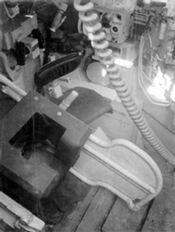 The M48 traveled at speeds of about 30 mph. Armor plating on the M48 varied from 76-120 mm, with the heaviest armor reserved for the front of the tank's hull. The M48 was separated into three compartments: the driver's compartment, the fighting compartment where the Gunner, Loader, and Tank Commander fought, and the engine compartment. The M48 carried a 90mm turret-mounted main gun, capable of rotating to fire in any direction, as well as one 7.62 mm machine gun, and one .50 caliber machine gun. Above the main gun was a 1 million candlepower Xenon searchlight. It was bore sighted with the main gun and gun sights so that it could be used to illuminate a target at night. M48 Specifications Line Drawings, Schematic M48
The M48 traveled at speeds of about 30 mph. Armor plating on the M48 varied from 76-120 mm, with the heaviest armor reserved for the front of the tank's hull. The M48 was separated into three compartments: the driver's compartment, the fighting compartment where the Gunner, Loader, and Tank Commander fought, and the engine compartment. The M48 carried a 90mm turret-mounted main gun, capable of rotating to fire in any direction, as well as one 7.62 mm machine gun, and one .50 caliber machine gun. Above the main gun was a 1 million candlepower Xenon searchlight. It was bore sighted with the main gun and gun sights so that it could be used to illuminate a target at night. M48 Specifications Line Drawings, Schematic M48
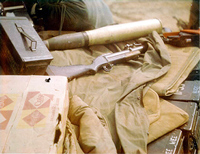 The entire purpose of the tank is to carry the main gun into battle. The armor is provided to ensure that the crew is protected from shrapnel (a main cause of battlefield casualties) and small fire. The driver gets the tank to firing position, the TC selects targets, the loader ensures the weapon is loaded with the correct ammunition, and the gunner ensures the round strikes the target.
The entire purpose of the tank is to carry the main gun into battle. The armor is provided to ensure that the crew is protected from shrapnel (a main cause of battlefield casualties) and small fire. The driver gets the tank to firing position, the TC selects targets, the loader ensures the weapon is loaded with the correct ammunition, and the gunner ensures the round strikes the target.
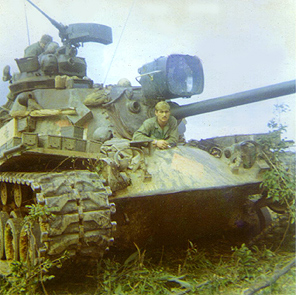 When first deployed, the M48-A3 had for the 1960's a state-of-the-art fire control system. At the time computers were mechanical, and range to the target was provided by a stereoscopic range finder, which functioned similarly to a 35mm camera. An end-box on each side of the turret exterior held a prism-type mirror. Turning a hand-crank on the range finder would pivot these mirrors until the double-image in the range finder merged. As the distance between the mirrors is exactly known, a little trigonometry provided the range (in meters) to the target. This information was displayed on a range indicator, and also fed to the ballistic computer by a rotating shaft. The ballistic computer was a collection of gears and cams (nothing was solid state) that had a handle so that the gunner could select the type of ammunition that was to be fired. Each round had a different muzzle velocity, and therefore the computer had a different cam for each type. The computer would take the range data, merge it with the velocity data, and via a set of rotating shafts, supply this information to the gun's super-elevation mechanism, resulting in the gun being elevated above the gunners line of sight sufficiently for the round to overcome the downward pull of gravity on its way to the target. The gunner's sight however remained locked on the target.
When first deployed, the M48-A3 had for the 1960's a state-of-the-art fire control system. At the time computers were mechanical, and range to the target was provided by a stereoscopic range finder, which functioned similarly to a 35mm camera. An end-box on each side of the turret exterior held a prism-type mirror. Turning a hand-crank on the range finder would pivot these mirrors until the double-image in the range finder merged. As the distance between the mirrors is exactly known, a little trigonometry provided the range (in meters) to the target. This information was displayed on a range indicator, and also fed to the ballistic computer by a rotating shaft. The ballistic computer was a collection of gears and cams (nothing was solid state) that had a handle so that the gunner could select the type of ammunition that was to be fired. Each round had a different muzzle velocity, and therefore the computer had a different cam for each type. The computer would take the range data, merge it with the velocity data, and via a set of rotating shafts, supply this information to the gun's super-elevation mechanism, resulting in the gun being elevated above the gunners line of sight sufficiently for the round to overcome the downward pull of gravity on its way to the target. The gunner's sight however remained locked on the target.
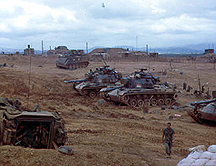 A good crew, in peacetime qualification, was able to stop from a speed of 20 mph, acquire the target, and get off a first round kill at 2,000 yards in seven seconds; 90% of the time. This required excellent teamwork and communication on the part of the entire crew. In Vietnam where typical engagement ranges could be measured in feet rather than in yards made the precision fire control system almost irrelevant. It was not unusual to have the TC lay the main gun by eye and fired using the commander's override control. Most M48's in Vietnam had the TC .50 cal mounted on top of the cupola on a simple pintle mount. This location gave a better field of fire, was faster to reload, increase the capacity of available ammo to fire, and less prone to jamming than when the M2 was placed on its side inside the armored cupola. It was not unusual to see the gunner, loader, and TC riding on the turret roof or the hatch lids when mines were expected.
A good crew, in peacetime qualification, was able to stop from a speed of 20 mph, acquire the target, and get off a first round kill at 2,000 yards in seven seconds; 90% of the time. This required excellent teamwork and communication on the part of the entire crew. In Vietnam where typical engagement ranges could be measured in feet rather than in yards made the precision fire control system almost irrelevant. It was not unusual to have the TC lay the main gun by eye and fired using the commander's override control. Most M48's in Vietnam had the TC .50 cal mounted on top of the cupola on a simple pintle mount. This location gave a better field of fire, was faster to reload, increase the capacity of available ammo to fire, and less prone to jamming than when the M2 was placed on its side inside the armored cupola. It was not unusual to see the gunner, loader, and TC riding on the turret roof or the hatch lids when mines were expected.
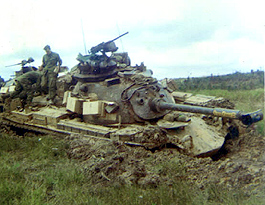 Rocket Propelled Grenades (RPG) were a constant threat in Vietnam; M48 tanks countered this threat by mounting spare track blocks on the infantry rail on the side of the turret. The bustle rack was extended with welded steel and loaded with cases of C-rations and the crew's duffel bags. Since anti-tank rounds require a certain standoff distance to function effectively, the track blocks, C-rations, and duffle bags acted as a standoff shield causing the RPG to explode prematurely.
Rocket Propelled Grenades (RPG) were a constant threat in Vietnam; M48 tanks countered this threat by mounting spare track blocks on the infantry rail on the side of the turret. The bustle rack was extended with welded steel and loaded with cases of C-rations and the crew's duffel bags. Since anti-tank rounds require a certain standoff distance to function effectively, the track blocks, C-rations, and duffle bags acted as a standoff shield causing the RPG to explode prematurely.
Canister and HE were the primary main gun ammunition types used in Vietnam. Beehive was effective, but usually in short supply. WP was useful, but dangerous to carry since it ignited if split open by a mine or RPG strike, so crews tended to expend it as soon as possible. Heat (HE) was usually preferred against bunkers.
Additional M48 photos

